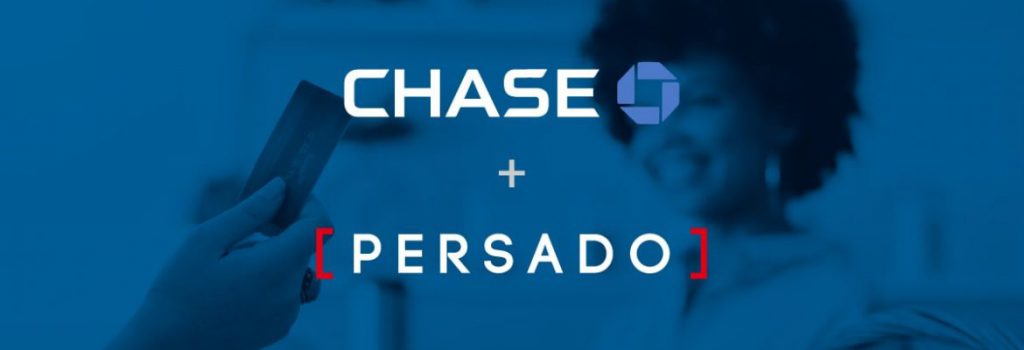The constantly evolving digital landscape has made marketing an even greater challenge than it had been before. Finding and keeping ideal audiences while keeping up with latest technologies and trends has become increasingly difficult. Yet there is hope! A game-changing solution has emerged that is transforming the way that marketers approach their work.
This solution is the incredibly exciting field of artificial intelligence in marketing. Thanks to AI, marketers can now automate business processes while still offering personalised content that speaks directly to their intended audience. AI offers more efficient targeting, thereby reducing guesswork and increasing accuracy. This enables businesses to focus their resources on the activities that offer the best possible results. The promise of AI is already proving true in various sectors, from healthcare and finance to marketing. Now, you too can take advantage of this cutting-edge technology to achieve a more effective marketing strategy, leading to greater reach, deeper engagement, and better revenues.
What Is Artificial Intelligence in Marketing?
The utilization of AI in marketing practices, often referred to as AI Marketing, is becoming increasingly popular. The concept involves the use of artificial intelligence to analyze customer data, thereby predicting and improving upon the customer journey. As technology continues to advance, businesses are beginning to harness the benefits AI can offer. Integrating machine learning into marketing strategies can provide companies with a more effective approach to attracting, nurturing, and converting prospects.
Additionally, AI can contribute to the development of better marketing strategies, creating an improved customer journey. The incorporation of AI and machine learning techniques into every stage of the customer lifecycle is demonstrated below in an informative graphic. In summary, AI Marketing continues to transform the marketing industry and offers a range of benefits for businesses looking for new and improved ways to engage with their customers.
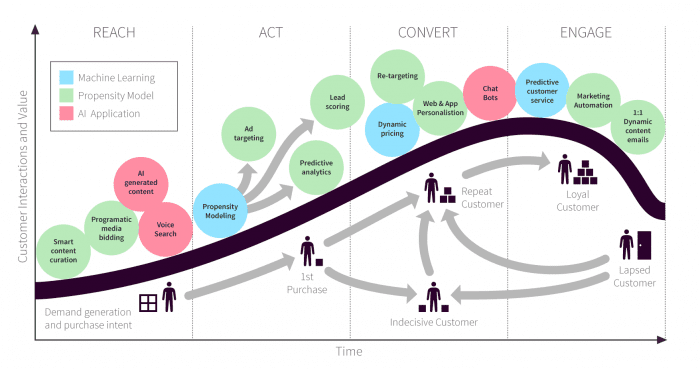
Source: Smart Insights
Examples of AI in Marketing
AI in marketing may feel more science fiction than fact to many, but it’s not a far-off concept; it’s here right now. According to Salesforce, just 29% of marketing leaders used AI in 2018, which surged to 84% by 2020
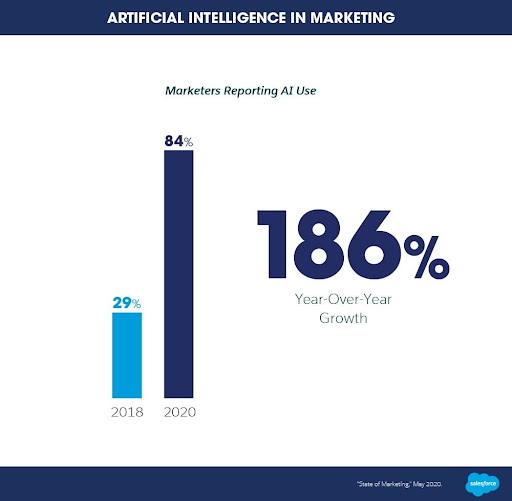
Source: Salesforce
So it’s no surprise that the global value of AI marketing is set to climb from $12 billion in 2020 to an eye-watering $108 billion in 2028.
If you haven’t considered the power of AI for marketing, now’s the time to learn more. To help you get started, we’ve compiled ten impressive AI marketing examples.
1. Whole Foods Leverages AI for Tailored Messaging
Up to 36% of consumers believe retailers should strive to offer more personalized experiences — rising to 43% among households earning $100,000 annually. Yet only 12% of retail brands think they’re good at delivering personalized experiences to shoppers.
To overcome this apparent expectation gap, grocery giant Whole Foods has opened 24 Just Walk Out stores across the US. Dotted with sensors and cameras, these outlets allow shoppers to pick up their items and leave without stopping at the register. Instead, orders are monitored and charged through AI.
Unsurprisingly, the whole “leave without paying” element of Just Walk Out has won all the headlines. But from a marketing perspective, the most exciting part of the strategy revolves around data collection.
All purchases are tracked to an individual level, allowing Whole Foods to leverage AI to analyze shopping activity, identify patterns, and predict future behaviors.
This initiative also opens the door to hyper-personalized marketing: if a customer regularly buys pasta, basil, and tinned tomatoes, the retailer could serve them with a promo code for other Italian-related ingredients.
2. ClickUp Uses NLP AI to Boost Blog Traffic By 85%
There’s been no shortage of opinions (and controversy) about AI-powered content writing.
However, using artificial intelligence for content creation isn’t just about asking ChatGPT to churn out thousands of words of copy and posting it straight to your blog.
For instance, project management solution ClickUp uses Surfer SEO’s natural language processing AI tools and machine learning technology to:
- Identify opportunities for content optimization;
- Understand which keywords to include in articles (and at what density);
- Gain insights into the ideal article structure, from the number of images included to the length of subheadings.

Source: Surfer SEO
The results have been striking. Since using Surfer SEO, ClickUp has seen an 85% upturn in organic, non-branded traffic.
Not only that, but the organization has also been able to produce more efficient content, completing over 130 optimizations and publishing more than 150 blogs.
3. BuzzFeed Personalizing Quiz Content With AI
Sticking with the content creation theme, BuzzFeed — one of the world’s best-known content websites, generating over 100 million monthly visits — is taking its first foray into AI-driven content.
However, the publisher insists it isn’t looking to replace human writers with robots. Instead, it’s using tools from OpenAI to deliver personalized content at scale in a way that wouldn’t be possible without automation and artificial intelligence.
BuzzFeed CEO Jonah Peretti said the AI-driven approach will help with “enhancing the quiz experience, informing our brainstorming, and personalizing our content for our audience.”
We can see initial results through several quizzes in collaboration between staff writers and “Buzzy the Robot,” the website’s AI creative assistant. For instance, one quiz uses the answers to seven questions to craft a “new life” for the reader:

Source: BuzzFeed
This surreal chunk of copy might not feel like “the future.” Still, it demonstrates how AI can help a website like BuzzFeed instantly craft unique content personalized to the behaviors of individual users.
4. Euroflorist Uses AI to Drive A/B Testing At Scale
Website A/B testing is highly effective for optimizing various on-page elements, from images to menu layouts to CTA buttons.
But there’s an obvious problem: as the name suggests, A/B testing involves pitching two variants against one another to find the winner. It could take you months of testing to arrive at the optimal result.
Once again, AI in marketing provides a solution. Unlike traditional A/B testing, platforms like Evolv AI use “massively multivariate testing” to find the perfect combo from thousands of variants. And it goes even further by dividing experiments into “generations” and testing only the top-performing variants from each generation until it identifies the best possible combination.
One company to benefit from this AI-driven approach to A/B testing is Euroflorist, which ran an 11-week experiment that underwent four generations of testing.
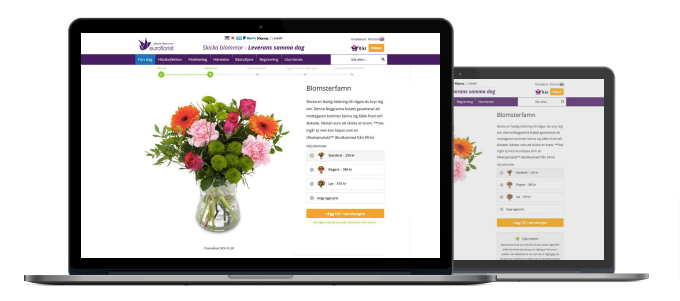
Source: Evolv AI
The winning combo boosted website conversion rates by 4.3%, helping the florist generate more sales and revenue.
5. Interactive Investor Slashes CPAs With AI PPC Optimizations
Pay-per-click advertising is a highly competitive field that relies heavily on data analysis and optimization. Without the proper tools and expertise, businesses may fall short in achieving optimal campaign performance, resulting in lower returns on investment and higher acquisition costs. Fortunately, with the rise of artificial intelligence technology, companies are now empowered to gain significant advantages in this space.
Interactive Investor, a leading online investment service, sought to drive more account signups and reduce customer acquisition costs through paid search campaigns. With the help of Albert, an advanced AI tool capable of designing and managing highly optimized campaigns across multiple marketing channels, Interactive Investor was able to achieve its goals. Albert utilized a set of KPIs provided by Interactive Investor to make real-time improvements to key campaign metrics, including demographic targeting, converting key words, ad copy, and campaign timing.
Through over 10,000 ads and a 286% increase in keywords, Interactive Investor was able to gain a massive 89% share of voice across the top 10 branded terms, ultimately resulting in significantly reduced cost per acquisition and generating promising outcomes.
6. Imagine Business Development Sees 100% Conversion Boost With AI-Led Email Timings
The average person currently receives almost 350 emails per day — a figure that’s set to surpass 375 emails by 2025. With so much noise, wouldn’t it be fantastic to send emails when individual recipients are most likely to open them?
Of course, if you’ve got more than a couple of dozen names on your marketing list, that sort of personalization simply wouldn’t be possible for mere humans to accomplish. But AI tools can manage it with ease.
For example, HubSpot agency partner Imagine Business Development leveraged the Seventh Sense AI platform, which uses artificial intelligence to optimize and personalize email delivery times for every person in a database.
In other words, if one recipient is most likely to open an email at 9:30 am, that’s when they’ll receive it.
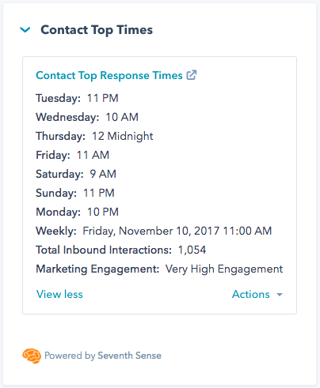
Source: HubSpot
Before working with Seventh Sense, Imagine Business Development saw average email open rates of around 20% and click-through rates of 2% – 3%. Not bad, but certainly not game-changing.
Seventh Sense changed all that, helping the agency double its open and click rates and increase total email conversions by a spectacular 100%.
7. Heinz Launches Its First Ad Campaign With Entirely AI-Generated Images
AI-generated images often get a bad rap (in fairness, the hands never look quite right). But Heinz — with the help of marketing agency Rethink Ideas — decided to launch what they described as “the first-ever ad campaign with visuals generated entirely by artificial intelligence.”
As is often the case, the campaign stemmed from a simple idea. After playing around with AI image generator DALL-E 2, Rethink Ideas noticed that prompts related to ketchup (like “ketchup in outer space” and “ketchup scuba diving”) frequently produced results that look just like bottles of Heinz.
So the agency urged consumers to get in on the act by sharing their own AI prompts for ketchup-based imagery, with the best creations appearing in social media posts and print ads:
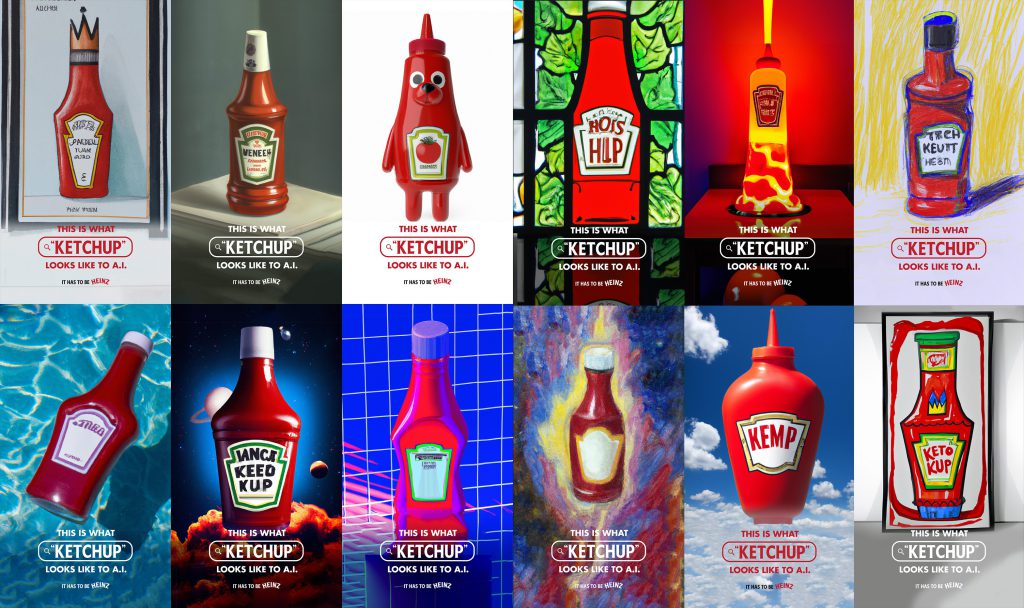
Source: Rethink Ideas
As Rethink Ideas explained: “It turns out that just like humans, AI prefers Heinz.”
8. Dept and Hello Monday Create AI-Powered “Shoe Mirror”
Vacant shop fronts are a problem for city centers, landlords, and neighboring businesses. Digital agencies Dept and Hello Monday came up with a solution: creating an AI-powered “Shoe Mirror” to turn empty stores into interactive, revenue-generating ads.
Here’s the idea: the Shoe Mirror analyzes what passersby are wearing, finds shoes that match their outfits, and places them on their (digital) feet through augmented reality, creating an experience personalized to each viewer.

Source: Dept
The technology even uses motion capture to replicate the user’s movements — so when they walk past a store, the mirror matches their gait.
But this isn’t just a fancy creative piece; it also has a revenue-driving edge. The digital storefront incorporates a QR code, which users can scan to buy physical versions of their new digital shoes from within the display.
9. Coca-Cola Launches Creative AI Platform
Coca-Cola stands out from other brands in its use of AI technology for marketing by launching its own AI platform that is exclusively designed for the company. A collaboration between OpenAI and Bain & Company, the “Create Real Magic” platform combines two AI technologies: GPT-4 and DALL-E. The former produces human-like text from search engine queries, while the latter turns text prompts into images.
This platform resulted in a campaign that encouraged Coca-Cola fans to create their own digital artwork utilizing branded assets such as the iconic contour bottle and script logo. The artists were given the opportunity to submit their works, with the best ones being showcased on digital billboards in New York’s Time Square and London’s Piccadilly Circus.
Coca-Cola’s Chief Marketing Officer Manolo Arroyo stresses that AI has numerous applications to enhance their marketing strategy, including content creation, personalization and engagement with their consumers. This campaign is a testament to the potential of AI technology and its benefits to companies such as Coca-Cola.
10. Magnolia Market Bridges Online-to-Offline
Magnolia Market, the brick-and-mortar shop owned by Joanna and Chip Gaines, is known for its stellar customer experience. The mission of Magnolia’s physical location is to “inspire you to own the space you’re in.” To achieve this goal, they created an authentic brand experience combining food, games, shopping, and a garden.
Because not everyone can visit the Magnolia Silos, the team felt that its e-commerce operation also needed to deliver the same experience. Magnolia worked with Shopify Plus to create a storefront and an augmented reality app that allows users to view products in 3D and “place” them in their homes. AR allowed Magnolia to render its products with the highest possible photo realism. The results set Magnolia apart from the competition and strengthened its e-commerce arm, a key driver for company growth.
11. Chase Achieves More Humanity in its Copywriting
Chase Bank signed a five-year deal with Persado, a New York-based company that applies artificial intelligence to marketing creative. After testing Persado’s solutions, Chase found that using machine learning in their copywriting helped them achieve more humanity in their marketing.
For example, one digital ad written by humans read: “Access cash from the equity in your home.” Persado’s version read: “It’s true—You can unlock cash from the equity in your home.” The latter version performed better with customers.
Chase is the first to engage in this type of large-scale machine learning copywriting, but other brands are planning to expand the use of Persado’s technology. Persado says the company already works with 250 marketers across retail, finance, and hospitality.
12. Starbucks Uses Predictive Analytics to Serve Personalized Recommendations
According to the research firm Aberdeen, companies identifying customer needs through predictive analytics can increase their organic revenue by 21% year-over-year, compared to an average of 12% without predictive analytics.
Starbucks is one example of a brand using its loyalty card and mobile app to collect and analyze customer data. They announced plans for personalization back in 2016.
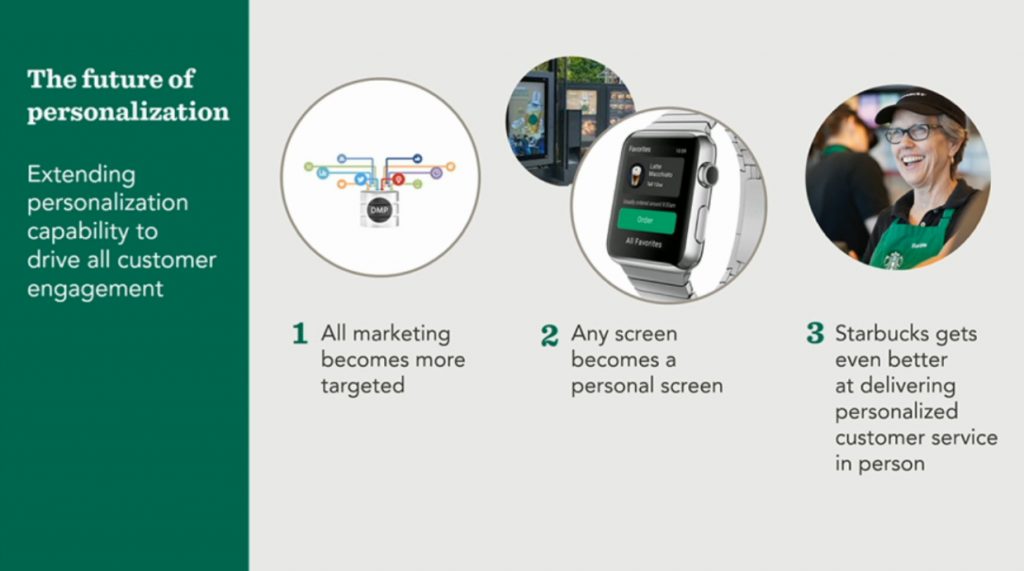
Source: GeekWire
Since then, they’ve built quite the app experience. It records purchases, including where they are made and at what time of day. Starbucks uses predictive analytics to serve customers with personalized marketing messages. They include recommendations when a user approaches a local store and special offers to increase the customer’s average order value.
13. Alibaba Opens a FashionAI Store
Alibaba, one of the biggest retail giants in the world, has taken the fashion industry by storm by opening a new physical store in Hong Kong that integrates Artificial Intelligence in its operations. Aptly named “FashionAI”, the store has been fitted with technology that will help streamline the fashion retail experience for customers.
Among the impressive tech features are garment tags that can detect when an item is touched and smart mirrors that can display and suggest clothing information and coordinating items. In an ambitious move, Alibaba also plans to bridge its brick-and-mortar with virtual stores, through the integration of a virtual wardrobe app, which will allow shoppers to view outfits they tried on in-store.
Alibaba’s decision to revolutionize the shopping experience and integrate technology is in response to shoppers’ changing expectations. According to a survey by the National Retail Federation, a significant 80% of consumers claimed retail technologies greatly enhanced their online buying experience, a testament to Alibaba’s innovative spirit.
14. Unilever Helps Ben & Jerry’s Identify the Trend for “Ice Cream for Breakfast”

Source: CampaignLive
Consumer goods company Unilever uses AI data centers across the globe to synthesize insights from various sources, including social listening, CRM, and traditional marketing research. Using this technology, Unilever discovered a link between ice cream and breakfast: at least 50 songs in the public domain include lyrics about “ice cream for breakfast,” and businesses like Dunkin’ Donuts are already selling ice cream in the morning.
Unilever took this insight and developed a range of cereal-flavored ice creams (including Fruit Loop and Frozen Flakes) for the Ben & Jerry’s brand.
15. Amazon Launches Personalize
Amazon was a pioneer in using machine learning to offer personalized product recommendations. Still, it has been a challenge for the brand to extend these capabilities to companies running their sites on Amazon Web Services.
In June 2019, Amazon announced the general availability of Amazon Personalize, which brings Amazon.com’s same machine learning technology to AWS customers for use in their applications.
The Amazon team has enhanced its functionality since the initial rollout. Personalize can now deliver up to 50% better recommendations across various fast-changing product types, including books, movies, music, and news articles.
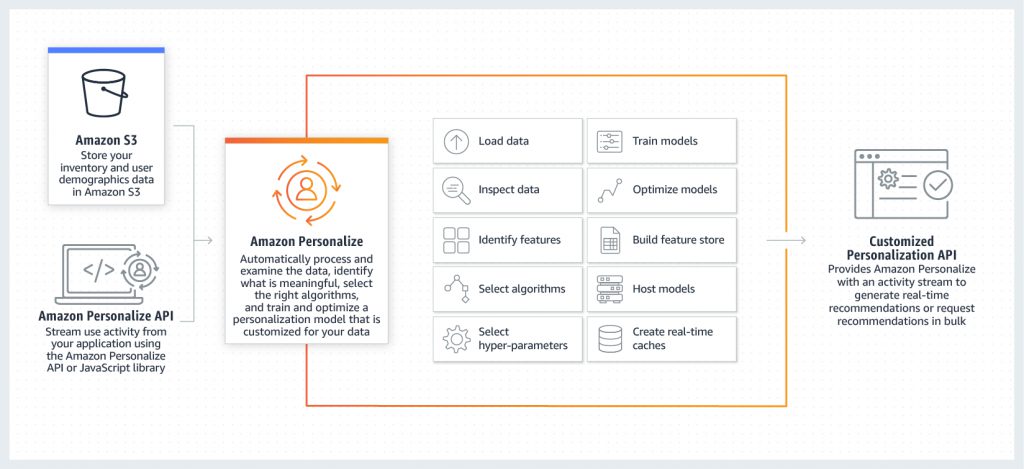
Source: VentureBeat
Brands including Domino’s, Yamaha, Subway, and the wedding company Zola already use Personalize to highlight musical instruments and in-store catalogs, deliver ingredient and flavor recommendations, and devise individualized style combinations.
16. Sephora Chatbots
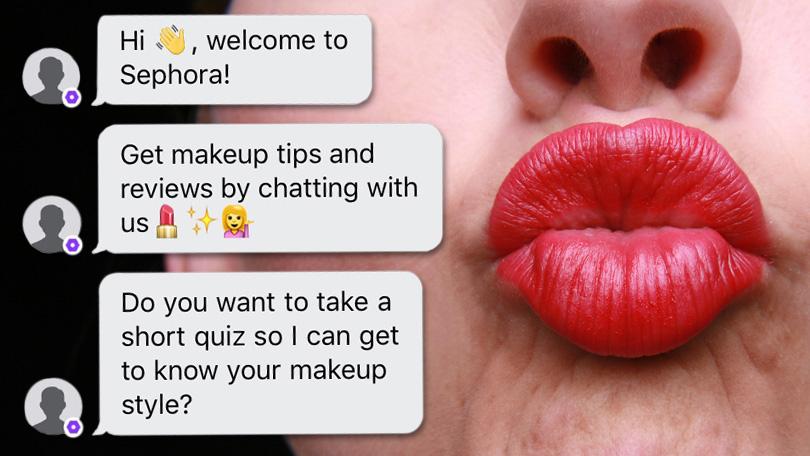
Source: Clickz
According to Drift’s latest State of Conversational Marketing report, chatbots are seeing faster growth than any other brand communication channel, with usage increasing by 92% between 2019 and 2020.
Beauty brand Sephora was an early adopter of AI. They began using a chatbot to dispense beauty advice on Kik in 2017.
Sephora’s chatbot helped consumers narrow choices, beginning with a quiz about their product preferences. Product preferences are beneficial in the cosmetics industry, where the options can be overwhelming and difficult to purchase without testing in person. Sephora gained valuable insights from its chatbot and saw enough engagement from that experiment that it’s since launched more chatbots on Messenger.
17. eBay Uses Brand Language Optimization to Drive Email Marketing Success
The global e-commerce marketplace eBay always strives to find new ways to engage customers. That means it’s got plenty of AI marketing examples to show us.
Since 2016, the company has been working with the artificial intelligence-powered customer experience platform Phrasee to enhance its marketing copy, focusing on email.
For an average brand, optimizing email marketing performance is relatively simple. A/B-test a couple of different subject lines or CTAs; see which works best; do more of it. But things get a little trickier for a company of eBay’s scale. With over 101 million email subscribers across the US, UK, and Germany alone, crafting impactful subject lines to drive open rates is a colossal undertaking.
Wanting to shift the creative burden away from its internal team, eBay turned to Phrasee, which uses a combination of natural language generation and deep learning to create copy at scale while dynamically optimizing performance.
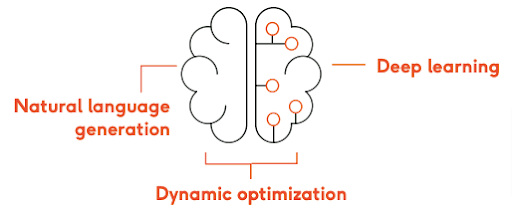
Source: Phrasee
Phrasee’s computational linguistics team built language models for eBay, allowing the e-commerce giant to generate custom copy tied to its brand tone, customer needs, and specific promotions at the click of a button.
In the years since it first teamed up with Phrasee, eBay has enjoyed substantial improvements in its key email marketing metrics, including:
- 16% average open uplift
- 700,000+ incremental opens per campaign
- 56,000+ incremental clicks per campaign
- 31% average click uplift
18. Marketing AI Helps AMA Boost Newsletter Engagement
As a marketer at the American Marketing Association (AMA), your job can be quite challenging. With a majority of your audience comprising marketing experts, it’s vital to ensure that the communication you send out is of high quality and personalized to meet the needs of individual members. But given the vast range of content covered by the AMA, it can be quite difficult to personalize communication for each of the 100,000+ subscribers on the newsletter list.
That’s where AI in marketing comes in handy. Through the AI-driven personalization platform offered by rasa.io, the AMA has been able to generate individualized subject lines based on member interest data, highlighting relevant and interesting content to every newsletter recipient. Since the AMA joined forces with rasa.io, their monthly subscriber engagement rate has increased by an impressive 42%.
With the ability to personalize communication for individuals in such a vast audience, the AMA can achieve its intended goals of engaging subscribers and providing valuable information and insights to its members.



